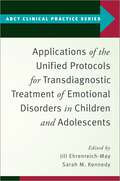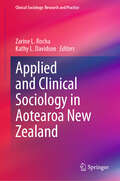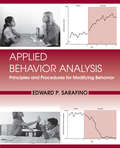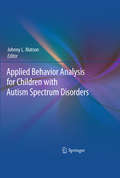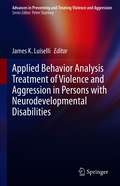- Table View
- List View
Applications of interactionist Psychology: Essays in Honor of Saul B. Sells
by Steven G. Cole and Robert G. DemareeThis work, honoring Saul B. Sells, adds to the understanding of the science of psychology and the application of that knowledge to meaningful human endeavors. Covers topics including: the interactionist approach and the importance of multivariate design, accuracy of measurement in order to move toward the understanding of human behavior, and the necessity of understanding personality characteristics and environmental affect. Important reading for researchers, students, and professionals in all subdisciplines of psychology, including personality development, social psychology, research methods, evaluation and measurement.
Applications of Item Response Theory To Practical Testing Problems
by F. M. LordPublished in 1980, Applications of Item Response Theory To Practical Testing Problems is a valuable contribution to the field of Education.
Applications of Item Response Theory To Practical Testing Problems
by F. M. LordPublished in 1980, Applications of Item Response Theory To Practical Testing Problems is a valuable contribution to the field of Education.
Applications of Nonverbal Behavioral Theories and Research
by Robert S. FeldmanThis book is intended to accomplish several goals. First, it is designed to provide a broad overview of the major areas of application of theory and research relating to nonverbal behavior. Second, individual chapters emphasize how the applications have been drawn from underlying theories and empirical bases, thereby making the link between theory, research, and applications apparent. Finally, the volume links individual chapter contributions, demonstrating how theoretical progress over the last few decades has led to important applied advances. The contributors to this book consider a wide variety of settings and topics. Their common thread, however, is a shared conviction that an understanding of nonverbal behavior can bring about an improvement in the human condition. Each of the authors has made suggestions regarding future directions for both research and practice -- and their ideas offer real promise.
Applications of Nonverbal Behavioral Theories and Research
by Robert S. FeldmanThis book is intended to accomplish several goals. First, it is designed to provide a broad overview of the major areas of application of theory and research relating to nonverbal behavior. Second, individual chapters emphasize how the applications have been drawn from underlying theories and empirical bases, thereby making the link between theory, research, and applications apparent. Finally, the volume links individual chapter contributions, demonstrating how theoretical progress over the last few decades has led to important applied advances. The contributors to this book consider a wide variety of settings and topics. Their common thread, however, is a shared conviction that an understanding of nonverbal behavior can bring about an improvement in the human condition. Each of the authors has made suggestions regarding future directions for both research and practice -- and their ideas offer real promise.
Applications of Nonverbal Communication (Claremont Symposium on Applied Social Psychology Series)
by Ronald E. Riggio Robert S. FeldmanThe goal of this edited volume is to provide a much needed bridge between the research on nonverbal communication and the application of those findings. The book features contributions from some of the leading researchers in the field. These distinguished scholars apply their understanding of nonverbal communication processes to a variety of settings including hospitals and clinics, courtrooms and police stations, the workplace and government, the classroom, and everyday life. It explores nonverbal communication in public settings, in intimate relationships, and across cultures and general lessons such as the importance of context, individual differences, and how expectations affect interpretation.Applications of Nonverbal Communication appeals to a diverse group of practitioners, researchers, and students from a variety of disciplines including psychology, health care, law enforcement, political science, sociology, communication, business and management. It may also serve as a supplement in upper level courses on nonverbal communication.
Applications of Nonverbal Communication (Claremont Symposium on Applied Social Psychology Series)
by Ronald E. Riggio Robert S. FeldmanThe goal of this edited volume is to provide a much needed bridge between the research on nonverbal communication and the application of those findings. The book features contributions from some of the leading researchers in the field. These distinguished scholars apply their understanding of nonverbal communication processes to a variety of settings including hospitals and clinics, courtrooms and police stations, the workplace and government, the classroom, and everyday life. It explores nonverbal communication in public settings, in intimate relationships, and across cultures and general lessons such as the importance of context, individual differences, and how expectations affect interpretation.Applications of Nonverbal Communication appeals to a diverse group of practitioners, researchers, and students from a variety of disciplines including psychology, health care, law enforcement, political science, sociology, communication, business and management. It may also serve as a supplement in upper level courses on nonverbal communication.
Applications of Parallel Processing in Vision (ISSN #Volume 86)
by J. R. BrannanConsiderable evidence exists that visual sensory information is analyzed simultaneously along two or more independent pathways. In the past two decades, researchers have extensively used the concept of parallel visual channels as a framework to direct their explorations of human vision. More recently, basic and clinical scientists have found such a dichotomy applicable to the way we organize our knowledge of visual development, higher order perception, and visual disorders, to name just a few. This volume attempts to provide a forum for gathering these different perspectives.
Applications of Social Psychology: How Social Psychology Can Contribute to the Solution of Real-World Problems (Sydney Symposium of Social Psychology)
by Joseph P. Forgas William D. Crano Klaus FiedlerThis book explores what social psychology can contribute to our understanding of real-life problems and how it can inform rational interventions in any area of social life. By reviewing some of the most recent achievements in applying social psychology to pressing contemporary problems, Forgas, Crano, and Fiedler convey a fundamentally optimistic message about social psychology’s achievements and prospects. The book is organized into four sections. Part I focuses on the basic issues and methods of applying social psychology to real-life problems, discussing evolutionary influences on human sociability, the role of psychological ‘mindsets’ in interpreting reality, and the use of attitude change techniques to promote adaptive behaviors. Part II explores the applications of social psychology to improve individual health and well-being, including managing aggression, eating disorders, and improving therapeutic interactions. Part III turns to the application of social psychology to improve interpersonal relations and communication, including attachment processes in social relationships, the role of parent-child interaction in preventing adolescent suicide, and analyzing social relations in legal settings and online social networks. Finally, Part IV addresses the question of how social psychology may improve our understanding of public affairs and political behavior. The book will be of interest to students and academics in social psychology, and professionals working in applied settings.
Applications of Social Psychology: How Social Psychology Can Contribute to the Solution of Real-World Problems (Sydney Symposium of Social Psychology)
by Partridge Joseph P. Forgas William D. Crano Klaus FiedlerThis book explores what social psychology can contribute to our understanding of real-life problems and how it can inform rational interventions in any area of social life. By reviewing some of the most recent achievements in applying social psychology to pressing contemporary problems, Forgas, Crano, and Fiedler convey a fundamentally optimistic message about social psychology’s achievements and prospects. The book is organized into four sections. Part I focuses on the basic issues and methods of applying social psychology to real-life problems, discussing evolutionary influences on human sociability, the role of psychological ‘mindsets’ in interpreting reality, and the use of attitude change techniques to promote adaptive behaviors. Part II explores the applications of social psychology to improve individual health and well-being, including managing aggression, eating disorders, and improving therapeutic interactions. Part III turns to the application of social psychology to improve interpersonal relations and communication, including attachment processes in social relationships, the role of parent-child interaction in preventing adolescent suicide, and analyzing social relations in legal settings and online social networks. Finally, Part IV addresses the question of how social psychology may improve our understanding of public affairs and political behavior. The book will be of interest to students and academics in social psychology, and professionals working in applied settings.
Applications of the Unified Protocol for Transdiagnostic Treatment of Emotional Disorders (ABCT Clinical Practice Series)
by David H. Barlow Todd J. FarchioneRecent conceptualization of anxiety, depressive, and related "emotional" disorders emphasize their similarities rather than their differences. In response, there has been a movement in recent years away from traditional disorder-specific manuals for the treatment of these disorders and toward treatment approaches that focus on addressing psychological processes that appear to cut across disorders. These "transdiagnostic" evidence-based treatments may prove to be more cost efficient and have the potential to increase availability of evidence-based treatments to meet a significant public health need. Among clinicians, the Unified Protocol for Transdiagnostic Treatment of Emotional Disorders (UP), developed by Dr. David Barlow and colleagues, is the most recognizable and widely used transdiagnostic treatment protocol with empirical support for its use. Applications of the Unified Protocol for Transdiagnostic Treatment of Emotional Disorders provides clinicians with a "how to" guide for using the UP to treat a broad range of commonly encountered psychological disorders in adults. Each chapter covers a specific anxiety, depressive, or related "emotional" disorder, and important transdiagnostic processes are highlighted and discussed in relation to treatment. Case studies are employed throughout to illustrate the real-world application of this unique cognitive behavioral protocol and to instruct clinicians in the nuts and bolts of assessment, case formulation, and treatment in accordance with a transdiagnostic perspective.
Applications of the Unified Protocol for Transdiagnostic Treatment of Emotional Disorders (ABCT Clinical Practice Series)
Recent conceptualization of anxiety, depressive, and related "emotional" disorders emphasize their similarities rather than their differences. In response, there has been a movement in recent years away from traditional disorder-specific manuals for the treatment of these disorders and toward treatment approaches that focus on addressing psychological processes that appear to cut across disorders. These "transdiagnostic" evidence-based treatments may prove to be more cost efficient and have the potential to increase availability of evidence-based treatments to meet a significant public health need. Among clinicians, the Unified Protocol for Transdiagnostic Treatment of Emotional Disorders (UP), developed by Dr. David Barlow and colleagues, is the most recognizable and widely used transdiagnostic treatment protocol with empirical support for its use. Applications of the Unified Protocol for Transdiagnostic Treatment of Emotional Disorders provides clinicians with a "how to" guide for using the UP to treat a broad range of commonly encountered psychological disorders in adults. Each chapter covers a specific anxiety, depressive, or related "emotional" disorder, and important transdiagnostic processes are highlighted and discussed in relation to treatment. Case studies are employed throughout to illustrate the real-world application of this unique cognitive behavioral protocol and to instruct clinicians in the nuts and bolts of assessment, case formulation, and treatment in accordance with a transdiagnostic perspective.
Applications of the Unified Protocol in Health Conditions
by Jorge Osma, Todd J. FarchionePeople diagnosed with different health conditions often experience emotional disorders or anxiety and depressive symptoms at some point. The Unified Protocol (UP) is a transdiagnostic treatment protocol that aims to improve emotion regulation difficulties contributing to emotional disorder symptoms (including comorbidity) and other affective components related to the physical disease. In Applications of the Unified Protocol in Health Conditions, the leading UP experts provide valuable insights to clinicians into how the UP--a single, scalable, cognitive behavioral therapy protocol--can be modified in relatively minor ways to address the emotional difficulties that often accompany these health conditions in different treatment settings. This book provides clinicians with a "how to" guide for using the UP to treat a range of commonly encountered mental health issues that are present in health conditions in adults. Each chapter focuses on a specific health condition and provides a rationale for using the UP in treatment, a description of how to apply core UP treatment modules, and guidance on making adaptions to the protocol. Application of the protocol is illustrated through case studies that include case conceptualization, treatment planning, and assessment of clinical outcomes.
Applications of the Unified Protocol in Health Conditions
People diagnosed with different health conditions often experience emotional disorders or anxiety and depressive symptoms at some point. The Unified Protocol (UP) is a transdiagnostic treatment protocol that aims to improve emotion regulation difficulties contributing to emotional disorder symptoms (including comorbidity) and other affective components related to the physical disease. In Applications of the Unified Protocol in Health Conditions, the leading UP experts provide valuable insights to clinicians into how the UP--a single, scalable, cognitive behavioral therapy protocol--can be modified in relatively minor ways to address the emotional difficulties that often accompany these health conditions in different treatment settings. This book provides clinicians with a "how to" guide for using the UP to treat a range of commonly encountered mental health issues that are present in health conditions in adults. Each chapter focuses on a specific health condition and provides a rationale for using the UP in treatment, a description of how to apply core UP treatment modules, and guidance on making adaptions to the protocol. Application of the protocol is illustrated through case studies that include case conceptualization, treatment planning, and assessment of clinical outcomes.
Applications of the Unified Protocols for Transdiagnostic Treatment of Emotional Disorders in Children and Adolescents (ABCT Clinical Practice Series)
by Jill Ehrenreich-May Sarah M. KennedyThe Unified Protocols for Transdiagnostic Treatment of Emotional Disorders in Children (UP-C) and Adolescents (UP-A) are evidence-based interventions originally designed to target core dysfunctions underlying emotional disorders, such as anxiety and depressive disorders, in children and adolescents. However, the UP-C and UP-A re increasingly being used to address other diagnostic clusters and problem areas that share these same core dysfunctions in a diverse range of delivery settings and cultural contexts. Applications of the Unified Protocols for Transdiagnostic Treatment of Emotional Disorders in Children and Adolescents is a practical guide for clinicians and researchers on applying the core principles of the UP-C and UP-A to treat children and adolescents with a broad range of emotion disturbance across settings in which youth typically receive care, including community mental health settings, pediatric primary care, and telehealth. In addition to providing an overview of the rationale for using UP-C and/or UP-A with each presenting problem or within each delivery setting, chapters provide detailed, step-by-step guidance on adapting and applying the UP-C and UP-A for their particular problem area, delivery setting, or cultural context. Chapters include case examples, suggestions for overcoming potential barriers in clinical delivery, and practical "tip sheets" for clinicians. When used in conjunction with the UP-C and UP-A Therapist Guide and Workbooks, this volume is an essential resource for clinicians using transdiagnostic interventions to treat diverse, complex, and comorbid clients in real-world therapy settings.
Applications of the Unified Protocols for Transdiagnostic Treatment of Emotional Disorders in Children and Adolescents (ABCT Clinical Practice Series)
by Jill Ehrenreich-May Sarah M. KennedyThe Unified Protocols for Transdiagnostic Treatment of Emotional Disorders in Children (UP-C) and Adolescents (UP-A) are evidence-based interventions originally designed to target core dysfunctions underlying emotional disorders, such as anxiety and depressive disorders, in children and adolescents. However, the UP-C and UP-A re increasingly being used to address other diagnostic clusters and problem areas that share these same core dysfunctions in a diverse range of delivery settings and cultural contexts. Applications of the Unified Protocols for Transdiagnostic Treatment of Emotional Disorders in Children and Adolescents is a practical guide for clinicians and researchers on applying the core principles of the UP-C and UP-A to treat children and adolescents with a broad range of emotion disturbance across settings in which youth typically receive care, including community mental health settings, pediatric primary care, and telehealth. In addition to providing an overview of the rationale for using UP-C and/or UP-A with each presenting problem or within each delivery setting, chapters provide detailed, step-by-step guidance on adapting and applying the UP-C and UP-A for their particular problem area, delivery setting, or cultural context. Chapters include case examples, suggestions for overcoming potential barriers in clinical delivery, and practical "tip sheets" for clinicians. When used in conjunction with the UP-C and UP-A Therapist Guide and Workbooks, this volume is an essential resource for clinicians using transdiagnostic interventions to treat diverse, complex, and comorbid clients in real-world therapy settings.
Applied and Clinical Sociology in Aotearoa New Zealand (Clinical Sociology: Research and Practice)
by Zarine L. Rocha Kathy L. DavidsonThis is the first volume to explore clinical and applied sociology in Aotearoa New Zealand, while also providing unique insights into the practice of sociology internationally. Drawing out the intersections between sociological research, public sociology and applied sociology, the chapters in this volume enrich the rapidly growing field of international clinical sociology. Aotearoa New Zealand presents an important case study in the development and practice of sociology: with a vibrant social scientific community and a significant diversity of scholars and practitioners, local research and practice highlight the country’s innovative and often unusual approaches to addressing social problems. This volume brings together a diversity of scholars and practitioners, from the country’s top sociologists to early career researchers, and provides a comprehensive and valuable exploration of sociology and its many practical applications in this unique context. It covers a wide range of key topics in the field, from the challenges of practicing a public sociology in Aotearoa New Zealand to the role of applied and clinical sociologists in government and consultancies. Contemporary social issues are explored as case studies, including practising sociological psychotherapy; indigenous applications of sociology and Māori language learning; and applying sociology within healthcare. This is a key addition to applied and clinical sociology literature.
Applied Asset and Risk Management: A Guide to Modern Portfolio Management and Behavior-Driven Markets (Management for Professionals)
by Marcus Schulmerich Yves-Michel Leporcher Ching-Hwa EuThis book is a guide to asset and risk management from a practical point of view. It is centered around two questions triggered by the global events on the stock markets since the middle of the last decade: - Why do crashes happen when in theory they should not? - How do investors deal with such crises in terms of their risk measurement and management and as a consequence, what are the implications for the chosen investment strategies? The book presents and discusses two different approaches to finance and investing, i.e., modern portfolio theory and behavioral finance, and provides an overview of stock market anomalies and historical crashes. It is intended to serve as a comprehensive introduction to asset and risk management for bachelor’s and master’s students in this field as well as for young professionals in the asset management industry. A key part of this book is the exercises to further demonstrate the concepts presented with examples and a step-by-step business case. An Excel file with the calculations and solutions for all 17 examples as well as all business case calculations can be downloaded at extras.springer.com.
Applied Behavior Analysis: Fifty Case Studies in Home, School, and Community Settings
by Kimberly Maich Darren Levine Carmen HallThis textbook offers real-world case studies for using Applied Behavior Analysis (ABA) to create, implement, and appraise behavior intervention programs across a variety of client situations. Its chapters are formatted for ease of use and retention and organized to focus on the core components of ABA: assessment, planning, implementation, evaluation, and research/ethics. Illustrative cases represent a diversity of problem behaviors, settings, social contexts, and life stages, and includes questions about data collection, goal setting, communication with families, and other processes of effective ABA practice. Together they emphasize not only the content knowledge involved in designing interventions, but also the interpersonal skills necessary for helping change complex challenging behaviors.These fifty case studies:Are suited to individual or team training.Present guiding questions regarding ABA process and professional practice.Feature charts, forms, templates, and other practical tools.Include links to Behavior Analyst Certification Board resources.Demonstrate the flexibility of ABA for use with children, adolescents, adults, or seniors.Applied Behavior Analysis: Fifty Case Studies in Home, School, and Community Settings is an essential text for graduate students, researchers, and practitioners in child and school psychology, behavior analysis, learning and instruction, counseling, and education. This singular volume models critical thinking and professional development in keeping with best practices and professional standards.
Applied Behavior Analysis: Principles and Procedures in Behavior Modification
by Edward P. SarafinoSarafino's goal in Principles and Procedures for Modifying Behavior is to create a clear and engaging instrument that describes ways to analyze one's own specific behaviors in terms of the factors that lead to and maintain them and ways to manage those factors to improve the behaviors. The text is based on research, theory, and experiences to explain and provide examples of the concepts and methods of self-management in a comprehensive text. It focuses on topics in applied behavior analysis, behavior modification, behavior therapy, and psychology of learning. Two general topics shaped this text: making the book relative to a variety of fields by describing applications in psychology, education, counseling, nursing, and physical therapy and different academic levels and preparation. Several important objectives guided the content and organization of the text which is designed to cover a large majority of tasks or concepts that the Behavior Analyst Certification Board (www.bacb.com) has identified as the field's essential content and should be mastered by all behavior analysts.
Applied Behavior Analysis Advanced Guidebook: A Manual for Professional Practice
by James K. LuiselliThe Applied Behavior Analysis Practice Guidebook: A Manual for Professional Practice gives behavioral practitioners pragmatic advice, direction and recommendations for being an effective clinician, consultant, supervisor and performance manager. The book adopts a how to do it perspective featuring contributions from expert scientist-practitioners. Each chapter introduces the relevance of the topic for practicing professionals, describes and synthesizes the empirical basis of the topic, and then presents practitioner recommendations. With this format, readers can navigate the chapters with familiarity and confidence to facilitate the understanding of content and integration of the many practice areas addressed.Focuses on the professional practice areas of board certified behavior analysts Includes forms, tables, flowcharts and other visual aids to assist in BCBA workConcludes each chapter with a practice guidelines checklistFeatures contributions from notable experts in distinct specialty areasHelps readers build skills and competencies as an applied behavior analyst
Applied Behavior Analysis for Children with Autism Spectrum Disorders
by Johnny L. MatsonAutism was once thought of as a rare condition, until the Centers for Disease Control and Prevention’s Autism and Developmental Disabilities Monitoring Network released the statistic that about 1 in every 150 eight-year-old children in various areas across the United States is afflicted by an autism spectrum disorder, or ASD. This news led to a dramatic expansion of research into autism spectrum disorders and to the emergence of applied behavior analysis (ABA) as the preferred method of treatment, even among prescribing practitioners. Applied Behavioral Analysis for Children with Autism Spectrum Disorders ably synthesizes research data and trends with best-practice interventions into a comprehensive, state-of-the-art resource. Within its chapters, leading experts review current ABA literature in depth; identify interventions most relevant to children across the autism spectrum; and discuss potential developments in these core areas: Assessment methods, from functional assessment to single case research designs. Treatment methods, including reinforcement, replacement behaviors, and other effective strategies. The role of the differential diagnosis in ABA treatment planning. Specific deficit areas: communication, social skills, stereotypies/rituals. Target behaviors, such as self-injury, aggression, adaptive and self-help problems. ASD-related training concerns, including maintenance and transition issues, and parent training programs. This volume is a vital resource for researchers, graduate students, and professionals in clinical child and school psychology as well as the related fields of education and mental health.
Applied Behavior Analysis Treatment of Violence and Aggression in Persons with Neurodevelopmental Disabilities (Advances in Preventing and Treating Violence and Aggression)
by James K. LuiselliThis book focuses on applied behavior analysis (ABA) treatment of violence and aggression in persons with neurodevelopmental disabilities. It details ABA theory and concepts leading to empirical treatment procedures that can be implemented successfully across diverse treatment settings. Further, the book examines contemporary approaches to functional behavioral assessment (FBA) and functional analysis (FA) in determining the environmental conditions responsible for violence and aggression. In addition, the volume describes several evidence-supported treatment procedures that encompass antecedent-control, contingency management, cognitive-behavior therapy, and physical intervention components. It addresses effective strategies for training and supervising care providers, including behavioral skills training (BST), posttraining performance management, and mindfulness. Finally, the book presents recommendations that guide effective and socially valid research-to-practice translation. Applied Behavior Analysis Treatment of Violence and Aggression in Persons with Neurodevelopmental Disabilities is an essential resource for researchers, clinicians/therapists, and upper-level undergraduate and graduate students in forensic psychology, public health, criminology/criminal justice, and behavioral therapy and rehabilitation.
Applied Behavior Science in Organizations: Consilience of Historical and Emerging Trends in Organizational Behavior Management (Behavior Science)
by Ramona A. Houmanfar Mitch Fryling Mark P. AlavosiusApplied Behavior Science in Organizations provides a compelling overview of the history of Organizational Behavior Management (OBM) and the opportunity it presents for designing and managing positive work environments that can in turn have a positive impact on society. The book brings together leading experts from industry and research settings to provide an overview of the historical approaches in Organizational Behavior Management. It begins with an introduction to recognized practices in OBM and the applications of fundamental principles of behavior analysis to a variety of performance problems in organizational settings. The book then highlights how organizational practices and consumers’ behavior combine in a complex confluence to meet an organization’s goals and satisfy consumer appetites, whilst often unintentionally affecting the wellbeing of organizational members. It argues that the science of behavior has a responsibility to contribute to the safety, health and wellbeing of organizational members, consumers of organizational products, and beyond. Finally, the book recognizes the essential role of organizations in initiating, shaping, and sustaining the development of more nurturing and reinforcing work environments, through discussion of the need for innovation while adapting and responding to growing social upheaval, technological advances, and environmental concerns, alongside crises in the global economy, health, education, and environment. Showcasing emerging work by internationally recognized scholars on the application of behavior science in organizations, the book will be an essential read for all students and professionals of Organizational Behavior Management, as well as those interested in using organizational applications to create new models of management.
Applied Behavior Science in Organizations: Consilience of Historical and Emerging Trends in Organizational Behavior Management (Behavior Science)
by Ramona A. Houmanfar Mitch Fryling Mark P. AlavosiusApplied Behavior Science in Organizations provides a compelling overview of the history of Organizational Behavior Management (OBM) and the opportunity it presents for designing and managing positive work environments that can in turn have a positive impact on society. The book brings together leading experts from industry and research settings to provide an overview of the historical approaches in Organizational Behavior Management. It begins with an introduction to recognized practices in OBM and the applications of fundamental principles of behavior analysis to a variety of performance problems in organizational settings. The book then highlights how organizational practices and consumers’ behavior combine in a complex confluence to meet an organization’s goals and satisfy consumer appetites, whilst often unintentionally affecting the wellbeing of organizational members. It argues that the science of behavior has a responsibility to contribute to the safety, health and wellbeing of organizational members, consumers of organizational products, and beyond. Finally, the book recognizes the essential role of organizations in initiating, shaping, and sustaining the development of more nurturing and reinforcing work environments, through discussion of the need for innovation while adapting and responding to growing social upheaval, technological advances, and environmental concerns, alongside crises in the global economy, health, education, and environment. Showcasing emerging work by internationally recognized scholars on the application of behavior science in organizations, the book will be an essential read for all students and professionals of Organizational Behavior Management, as well as those interested in using organizational applications to create new models of management.








